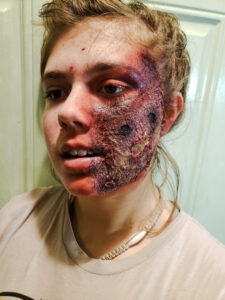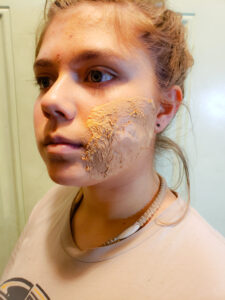My art portrays a third-degree facial burn created with special effects makeup showing the phases of skin tissue regeneration. The first two pictures depict the hemostasis and inflammation phases. The other two pictures are my interpretation of what the proliferation and scaring tissue formation phases would look like towards the end of the healing process. I used a combination of liquid latex and toilet paper to create layers of stratified squamous epithelium and connective tissue proper dense irregular. Connective tissue proper Loose Adipose can be seen in the yellowed areas of the tissue damage.




Abstract:
When burns are inflicted on the skin, multiple layers of the dermis are affected and work to repair the damage. This piece showcases the effects of a third-degree burn on the skin through special effects makeup. The art also shows the regeneration process, which is done in four steps. The first step, hemostasis, is when blood begins clotting in the surrounding tissues that were unaffected from the burn. Vessels also constrict to aid in preventing further blood loss. The second step, inflammation, consists of neutrophils and monocytes gathering at the affected area. The third step, which is called proliferation, occurs when new tissue is formed and other parts of the integumentary system are created to replace the damaged ones. During this step, myofibroblasts create contractions for the wound, allowing it to pull the edges together. The final step is called maturation. In this step, scars begin forming. This occurs because collagen fibers intertwine and complete the repairing of the skin. This final step of maturation and scarring takes the longest time out of all the steps in the healing process.